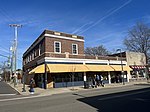Byrd Theatre
1928 establishments in VirginiaCinemas and movie theaters in VirginiaMovie palacesNational Register of Historic Places in Richmond, VirginiaTheatres completed in 1928 ... and 2 more
Theatres in Richmond, VirginiaTheatres on the National Register of Historic Places in Virginia

The Byrd Theatre is a cinema in the Carytown neighborhood of Richmond, Virginia. It was named after William Byrd II, the founder of the city. The theater opened on December 24, 1928 to much excitement and is affectionately referred to as "Richmond’s Movie Palace". Though equipped with a Wurlitzer pipe organ, the theatre was also one of the first of its kind to be originally outfitted for sound motion pictures.
Excerpt from the Wikipedia article Byrd Theatre (License: CC BY-SA 3.0, Authors, Images).Byrd Theatre
West Cary Street, Richmond Museum District
Geographical coordinates (GPS) Address Nearby Places Show on map
Geographical coordinates (GPS)
| Latitude | Longitude |
|---|---|
| N 37.5525 ° | E -77.478055555556 ° |
Address
West Cary Street 2920
23221 Richmond, Museum District
Virginia, United States
Open on Google Maps









